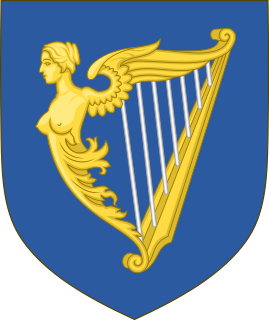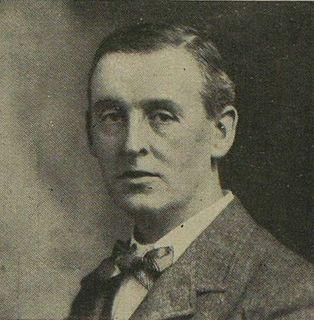
The Parliament of Northern Ireland was the Home Rule legislature of Northern Ireland, created under the Government of Ireland Act 1920, which sat from 7 June 1921 to 30 March 1972, when it was suspended with the introduction of Direct Rule. It was abolished under the Northern Ireland Constitution Act 1973.
The Labour Party is a social-democratic political party in the Republic of Ireland. Founded in 1912 in Clonmel, County Tipperary, by James Larkin, James Connolly, and William X. O'Brien as the political wing of the Irish Trades Union Congress, it describes itself as a "democratic socialist party" in its constitution. Labour continues to be the political arm of the Irish trade union and labour movement and seeks to represent workers interests in the Dáil and on a local level.

The Irish Parliamentary Party was formed in 1874 by Isaac Butt, the leader of the Nationalist Party, replacing the Home Rule League, as official parliamentary party for Irish nationalist Members of Parliament (MPs) elected to the House of Commons at Westminster within the United Kingdom of Great Britain and Ireland up until 1918. Its central objectives were legislative independence for Ireland and land reform. Its constitutional movement was instrumental in laying the groundwork for Irish self-government through three Irish Home Rule bills.

The 1955 United Kingdom general election was held on 26 May 1955, four years after the previous general election. It resulted in a substantially increased majority of 60 for the Conservative government under new leader and prime minister Sir Anthony Eden against the Labour Party, then in its twentieth year of leadership by Clement Attlee.

North Down is a parliamentary constituency in the United Kingdom House of Commons. The current MP is Sylvia Hermon, first elected in the 2001 general election. Hermon represented the constituency on behalf of the Ulster Unionist Party until 2010, subsequently sitting as an Independent.

Derry City Council was the local government authority for the city of Derry in Northern Ireland. It merged with Strabane District Council in April 2015 under local government reorganisation to become Derry and Strabane District Council.

The Redistribution of Seats Act 1885 was an Act of the Parliament of the United Kingdom. It was a piece of electoral reform legislation that redistributed the seats in the House of Commons, introducing the concept of equally populated constituencies, a concept in the broader global context termed equal apportionment, in an attempt to equalise representation across the UK. It was associated with, but not part of, the Representation of the People Act 1884.
Liverpool City Council has existed since 1880, when Liverpool was awarded city status. Prior to this date the local authority was a town council.

St Stephen's Green, a division of Dublin, was a UK parliamentary constituency in Ireland. It returned one Member of Parliament (MP) to the British House of Commons 1885–1922.
Dublin County was a parliamentary constituency represented in Dáil Éireann, the lower house of the Irish parliament or Oireachtas from 1921 to 1969. The method of election was the single transferable vote form of proportional representation (PR-STV).
Wednesbury was a borough constituency in England's Black Country which returned one Member of Parliament to the House of Commons of the Parliament of the United Kingdom from 1868 until it was abolished for the February 1974 general election.

The Representation of the People (Ireland) Act, 1832, commonly called the Irish Reform Act 1832, was an Act of Parliament that introduced wide-ranging changes to the election laws of Ireland. The act was passed at approximately the same time as the Reform Act 1832, which applied to England and Wales. The chief architects of the act were Francis Jeffrey and Henry Cockburn.

The Stockport by-election, 1920 was a parliamentary by-election held on 27 March 1920 for the constituency of Stockport, in Cheshire.
Alexander Blane was an Irish nationalist politician and Member of Parliament (MP) for South Armagh, 1885-92. He was a supporter of Charles Stewart Parnell during the Split in the Irish Parliamentary Party, and later a pioneering Socialist. In 1876 he was appointed agent to the Catholic Registration Association, an organization dedicated to maximising the Catholic vote. He was also president of the Prisoners’ Aid Society.

Elections for local government were held in Northern Ireland on 15 May 1985, contesting 565 seats in all.

The 1920 Irish local elections were held in January & June 1920 for the various county & district councils of Ireland. The elections provide an interesting barometer of opinion in Ireland during the early stages of the Irish War of Independence (1919–21), and were the last elections to be held on an all-Irish basis, with the Government of Ireland Act 1920 being passed at the end of the year, legislating for the partition of Ireland. The next local elections in Ireland were held in Northern Ireland in 1924, with the Irish Free State holding local elections in 1925.
The 1899 Irish local elections were the first local elections following the reorganisation of Irish local government caused by the Local Government (Ireland) Act 1898. The 1898 Act had changed the nature of Irish local governance, replacing the unrepresentative grand jury system, and making local government more democratic and representative. As a result, the 1899 election saw the traditional Unionist Landowning class, which had previously dominated much of Irish local politics, being replaced by a newer nationalist representation. Ulster's local government, however, remained Unionist in political outlook.
An election to Dublin Corporation took place in March 1905 as part of that year's Irish local elections. The election saw a small revival for Labour representatives, whilst the Unionist representation was cut by half.













